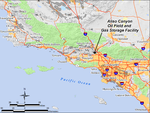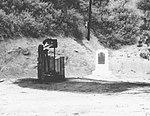Oat Mountain (California)
Geography of the San Fernando ValleyMountains of Los Angeles County, CaliforniaMountains of Southern CaliforniaSanta Susana Mountains
Oat Mountain is a peak of the Santa Susana Mountains overlooking the San Fernando Valley (near Los Angeles, California) to the south and southeast. Oat Mountain is the highest peak in the Santa Susana Mountains of California. The Los Angeles district of Chatsworth is to the south of the mountain. There are many microwave relay antennas as well as Doppler weather equipment at Oat Mountain. SoCal Gas has several wells in the area as well.
Excerpt from the Wikipedia article Oat Mountain (California) (License: CC BY-SA 3.0, Authors).Oat Mountain (California)
Palo Sola Truck Road,
Geographical coordinates (GPS) Address Nearby Places Show on map
Geographical coordinates (GPS)
| Latitude | Longitude |
|---|---|
| N 34.3297222 ° | E -118.6006433 ° |
Address
Palo Sola Truck Road
Palo Sola Truck Road
91326
California, United States
Open on Google Maps






